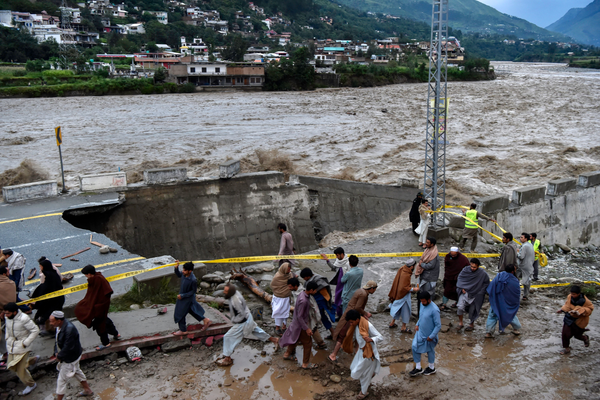Climate change likely worsened the devastating floods that inundated Pakistan this summer, according to a
new scientific analysis. Extreme rainfall has intensified across the country, and warming probably played a role.
The study also finds that these kinds of extreme rainfall events may grow even more severe as the planet gets hotter.
On supporting science journalism
If you're enjoying this article, consider supporting our award-winning journalism by subscribing. By purchasing a subscription you are helping to ensure the future of impactful stories about the discoveries and ideas shaping our world today.
The findings were published Wednesday by the science consortium World Weather Attribution, an international initiative specializing in the links between climate change and extreme weather events. The research team included an international group of experts, including researchers in Pakistan.
The new analysis investigates one of Pakistan’s worst flooding events on record. Unusually strong monsoon rains pounded the country for much of the summer, and August brought more than three times its usual rainfall for the month.
Pakistan’s southernmost provinces, Sindh and Balochistan, felt the worst of it. They each experienced their wettest August on record, with seven to eight times their normal rainfall.
The intense rains swelled the Indus River and triggered widespread flash floods, submerging large swaths of the country under water. Estimates suggest that at least 33 million people have been affected by the floods and 1,500 people have died.
The new study examined the event from two different angles. The researchers first looked at the 60-day period of heaviest rainfall across the Indus River basin, a wide geographic area. They also zeroed in on the five-day period of heaviest rainfall in Sindh and Balochistan, the worst affected areas.
They found that both events constitute a “1-in-100” year event in the present-day climate — that’s an event with about a 1 percent chance of occurring in any given year.
The researchers next examined long-term observational data to find out whether rainfall patterns have changed across the region over the years. They found that rainfall has indeed grown more intense — by about 50 percent for the 60-day event and by as much as 75 percent for the narrower five-day event.
Finally, the researchers used climate models to investigate the influence global warming may have had on intensifying rainfall in Pakistan. Models allow scientists to compare two sets of simulations — one representing the present-day climate and one representing a hypothetical world without any human-caused global warming.
The models generally suggested that climate change has increased the five-day rainfall totals in Sindh and Balochistan, upping them by as much as 50 percent.
The 60-day regionwide event is more complicated.
Monsoon rainfall in Pakistan is highly variable from one year to the next, partly because of the local geography and partly because these rains can be strongly influenced by temporary climate fluctuations, like La Niña events. As a result, climate models have some difficulties simulating monsoon rainfall across Pakistan. And that makes it hard to say with certainty how much of a role climate change has played.
That said, observations show that rainfall has intensified across the region over time. And scientists know, in theory, how warming should be physically affecting atmospheric moisture and rainfall patterns in this part of the world.
Put all together, “we now find that it’s likely climate change played a role,” said Sjoukje Philip, a study co-author and a researcher at the Royal Netherlands Meteorological Institute, at a press briefing announcing the findings Wednesday. It’s just hard to quantify exactly how much.
The researchers went one step further to investigate how future warming may affect these kinds of extreme rainfall events in the coming years. They used models to simulate a world that has warmed by about 2 degrees Celsius in total. (The world has warmed by about 1.2 C so far.)
The findings suggest that the five-day rainfall event will continue to intensify under future warming. Estimates for the 60-day event have major uncertainties because of the same modeling difficulties.
Extreme weather events are worsening all over the world under the influence of climate change. That makes them greater threats to human communities.
Still, the impacts of extreme weather on people heavily depend on a variety of other factors, including socioeconomic conditions, early warning systems and disaster management plans. World Weather Attribution analyses typically examine these factors as well.
The new analysis notes that the devastating impact of this summer’s floods were driven by a range of factors. Many affected communities were in close proximity to floodplains and were made more vulnerable by high poverty rates.
The report also cites inadequate infrastructure and outdated river management plans. And it suggests that top-down disaster management plans may result in a disconnect between policies devised at top governmental levels and the concerns of communities at local levels.
Some experts also suggest that the legacy of colonial rule in Pakistan has, to this day, influenced the country’s engineering and water management strategies and affected its vulnerability to disasters like floods.
“It is important to remember that the disaster was a result of vulnerability constructed over a number of years,” said Ayesha Siddiqi, a study co-author and a researcher at the University of Cambridge, who has previously studied the impact of floods in Pakistan. “And it shouldn’t be seen ahistorically as the outcome of one kind of sudden or sporadic weather event.”
Reprinted from E&E News with permission from POLITICO, LLC. Copyright 2022. E&E News provides essential news for energy and environment professionals.
